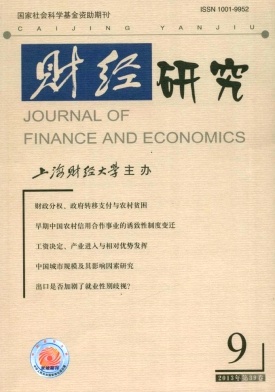我国财政支出挤入挤出效应的动态时间路径分析——基于MS-VECM的实证检验
财经研究 2013 年 第 39 卷第 09 期, 页码:20 - 35
摘要
参考文献
摘要
文章利用1990-2012年的季度数据,采用变参数的MS-VECM模型考察了我国财政支出与私人投资的区制状态、转移概率和区制相关性。研究发现,在不同的经济发展阶段,财政支出对私人投资的影响不同,表现出挤出效应和挤入效应交替的区制转移特征。进一步研究还发现,挤出效应主要发生在财政支出增速较快和经济过热、通胀压力较大的阶段。文章结果表明,为了避免挤出效应的发生,在财政支出的融资安排上应考虑私人部门的融资约束,避免对私人投资的挤占,并且在经济过热或通胀压力较大时应适时淡出扩张性财政政策。
关键词
[1]陈浪南,杨子晖.中国政府支出和融资对私人投资挤出效应的经验研究[J].世界经济,2007,(1):49-59.
[2]楚尔鸣,鲁旭.基于SVAR模型的政府投资挤出效应研究[J].宏观经济研究,2008,(8):41-47.
[3]董秀良,薛丰慧,吴仁水.我国财政支出对私人投资影响的实证分析[J].当代经济研究,2006,(5):65-68.
[4]高铁梅,李晓芳,赵昕东.我国财政政策乘数效应的动态分析[J].财贸经济,2002,(2):40-45.
[5]郭庆旺,贾俊雪.财政投资的经济增长效应:实证分析[J].财贸经济,2005,(4):40-47...
[6]李树培,魏下海.我国财政支出对民间需求影响的动态分析(1978-2007)[J].上海经济研究,2009,(6):3-10.
[7]刘溶沧,马拴友.赤字、国债与经济增长关系的实证分析——兼评积极财政政策是否有挤出效应[J].经济研究,2001,(2):13-19.
[8]刘忠敏,马树才,陈素琼.我国政府支出和公共投资对私人投资的效应分析[J].经济问题,2009,(3):10-14.
[9]吴洪鹏,刘璐.挤出还是挤入:公共投资对民间投资的影响[J].世界经济,2007,(2):13-22.
[10]张勇,古明明.公共投资能否带动私人投资:对中国公共投资政策的再评价[J].世界经济,2011,(2):119-134.
[11]中国社会科学院财贸经济研究所课题组.积极的财政政策对中国经济增长的效应[J].经济学家,2003,(4):31-36.
[12]郑群峰,王迪,阚大学.中国政府投资挤出(挤入)效应空间计量研究[J].财贸研究,2011,(3):69-78.
[13]Afonso A,St Aubyn M.Macroeconomic rates of return of public and private invest-ment:Crowding-in and crowding-out effects[J].The Manchester School,2009,77(S1):21-39.
[14]Aschauer D A.Public investment and productivity growth in the group of seven[J].Economic Perspectives,1989,15(3):17-25.
[15]Blanchard O,Perotti R.An empirical characterization of the dynamic effects of changesin government spending and taxes on output[J].The Quarterly Journal of economics,2002,117(4):1329-1368.
[16]Blejer M I,Khan M S.Government policy and private investment in developing coun-tries[J].Staff Papers—International Monetary Fund,1984,31(2):379-403.
[17]Clements M P,Krolzig H M.A comparison of the forecasting performance of markov-switching and threshold autoregressive models of US GNP[J].The Econometrics Jour-nal,1998,1(1):47-75.
[18]Cochrane J H.Long-term debt and optimal policy in the fiscal theory of the price level[J].Econometrica,2001,69(1):69-116.
[19]Erden L,Holcomebe R G.The effects of public investment on private investment indeveloping economies[J].Public Finance Review,2005,33(5):575-602.
[20]Evans P,Karra G.Are government activities productive?Evidence from a panel of USStates[J].The Review of Economics and Statistics.1994,76(1):1-11.
[21]Fisher S.The role of macroeconomic factors in growth[J].Journal of Monetary Eco-nomics,1993,32(3):485-5l2.
[22]Furceri D,Sousa R M.The impact of government spending on the private sector:Crowding-out versus crowding-in effects[J].Kyklos,2011,64(4):516-533.
[23]Ghali K H.Public investment and private capital formation in a vector error-correctionmodel of growth[J].Journal of Applied Economics,1998,30(6):837-844...
[24]Goldsmith A H.Rethinking the relation between government spending and economicgrowth:A composition approach to fiscal policy instruction for principles students[J].The Journal of Economic Education,2008,39(2):153-173.
[25]Hamilton J D.A new approach to the economic analysis of nonstationary time seriesand the business cycle[J].Econometrica,1989,57(2):357-384.
[26]Hamilton J D,Susmel R.Autoregressive conditional heteroskedasticity and changes inregime[J].Journal of Econometrics,1994,64(1-2):307-333.
[27]Kim C J,Nelson C.A bayesian approach to testing for markov-switching in univariateand dynamic factor models[J].International Economic Review,2001,42(4):989-1013.
[28]Krolzig H M,Wohrmann D I A.Seignorage,government spending and growth in a lu-casian general equilibrium model[R].University of Oxford Economics Series WorkingPapers No.99187,1996.
[2]楚尔鸣,鲁旭.基于SVAR模型的政府投资挤出效应研究[J].宏观经济研究,2008,(8):41-47.
[3]董秀良,薛丰慧,吴仁水.我国财政支出对私人投资影响的实证分析[J].当代经济研究,2006,(5):65-68.
[4]高铁梅,李晓芳,赵昕东.我国财政政策乘数效应的动态分析[J].财贸经济,2002,(2):40-45.
[5]郭庆旺,贾俊雪.财政投资的经济增长效应:实证分析[J].财贸经济,2005,(4):40-47...
[6]李树培,魏下海.我国财政支出对民间需求影响的动态分析(1978-2007)[J].上海经济研究,2009,(6):3-10.
[7]刘溶沧,马拴友.赤字、国债与经济增长关系的实证分析——兼评积极财政政策是否有挤出效应[J].经济研究,2001,(2):13-19.
[8]刘忠敏,马树才,陈素琼.我国政府支出和公共投资对私人投资的效应分析[J].经济问题,2009,(3):10-14.
[9]吴洪鹏,刘璐.挤出还是挤入:公共投资对民间投资的影响[J].世界经济,2007,(2):13-22.
[10]张勇,古明明.公共投资能否带动私人投资:对中国公共投资政策的再评价[J].世界经济,2011,(2):119-134.
[11]中国社会科学院财贸经济研究所课题组.积极的财政政策对中国经济增长的效应[J].经济学家,2003,(4):31-36.
[12]郑群峰,王迪,阚大学.中国政府投资挤出(挤入)效应空间计量研究[J].财贸研究,2011,(3):69-78.
[13]Afonso A,St Aubyn M.Macroeconomic rates of return of public and private invest-ment:Crowding-in and crowding-out effects[J].The Manchester School,2009,77(S1):21-39.
[14]Aschauer D A.Public investment and productivity growth in the group of seven[J].Economic Perspectives,1989,15(3):17-25.
[15]Blanchard O,Perotti R.An empirical characterization of the dynamic effects of changesin government spending and taxes on output[J].The Quarterly Journal of economics,2002,117(4):1329-1368.
[16]Blejer M I,Khan M S.Government policy and private investment in developing coun-tries[J].Staff Papers—International Monetary Fund,1984,31(2):379-403.
[17]Clements M P,Krolzig H M.A comparison of the forecasting performance of markov-switching and threshold autoregressive models of US GNP[J].The Econometrics Jour-nal,1998,1(1):47-75.
[18]Cochrane J H.Long-term debt and optimal policy in the fiscal theory of the price level[J].Econometrica,2001,69(1):69-116.
[19]Erden L,Holcomebe R G.The effects of public investment on private investment indeveloping economies[J].Public Finance Review,2005,33(5):575-602.
[20]Evans P,Karra G.Are government activities productive?Evidence from a panel of USStates[J].The Review of Economics and Statistics.1994,76(1):1-11.
[21]Fisher S.The role of macroeconomic factors in growth[J].Journal of Monetary Eco-nomics,1993,32(3):485-5l2.
[22]Furceri D,Sousa R M.The impact of government spending on the private sector:Crowding-out versus crowding-in effects[J].Kyklos,2011,64(4):516-533.
[23]Ghali K H.Public investment and private capital formation in a vector error-correctionmodel of growth[J].Journal of Applied Economics,1998,30(6):837-844...
[24]Goldsmith A H.Rethinking the relation between government spending and economicgrowth:A composition approach to fiscal policy instruction for principles students[J].The Journal of Economic Education,2008,39(2):153-173.
[25]Hamilton J D.A new approach to the economic analysis of nonstationary time seriesand the business cycle[J].Econometrica,1989,57(2):357-384.
[26]Hamilton J D,Susmel R.Autoregressive conditional heteroskedasticity and changes inregime[J].Journal of Econometrics,1994,64(1-2):307-333.
[27]Kim C J,Nelson C.A bayesian approach to testing for markov-switching in univariateand dynamic factor models[J].International Economic Review,2001,42(4):989-1013.
[28]Krolzig H M,Wohrmann D I A.Seignorage,government spending and growth in a lu-casian general equilibrium model[R].University of Oxford Economics Series WorkingPapers No.99187,1996.
引用本文
帅雯君, 董秀良, 胡淳. 我国财政支出挤入挤出效应的动态时间路径分析——基于MS-VECM的实证检验[J]. 财经研究, 2013, 39(9): 20–35.
导出参考文献,格式为:





 10279
10279  4573
4573

